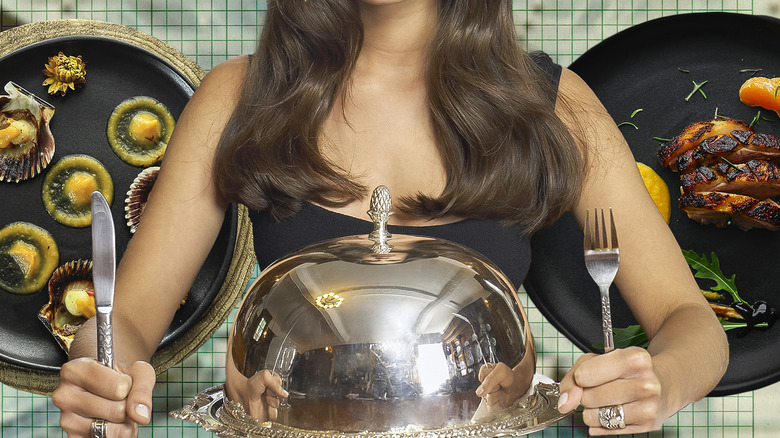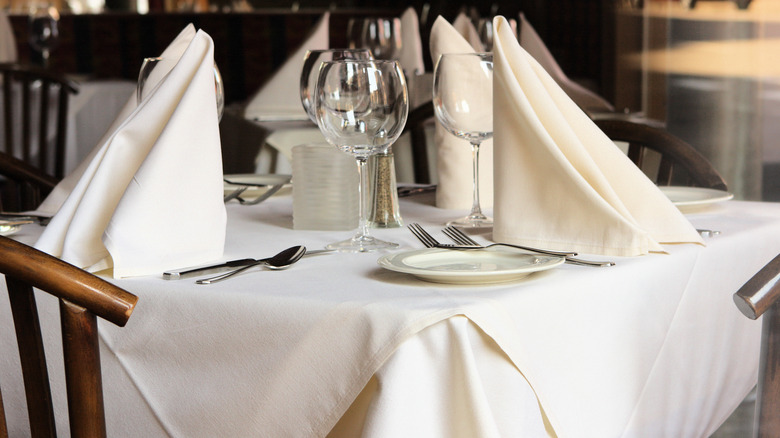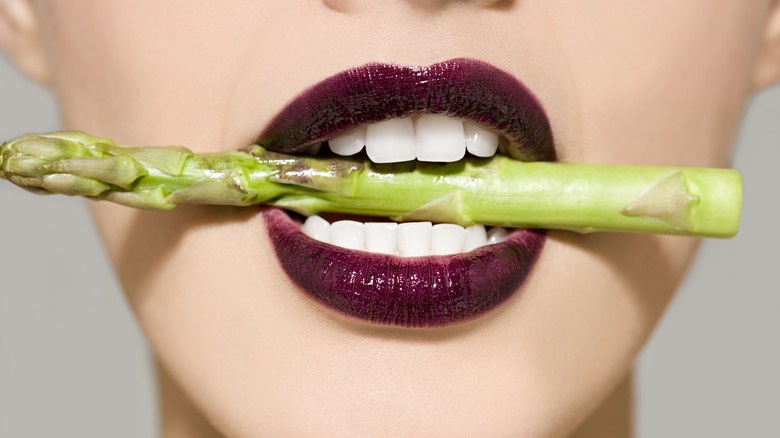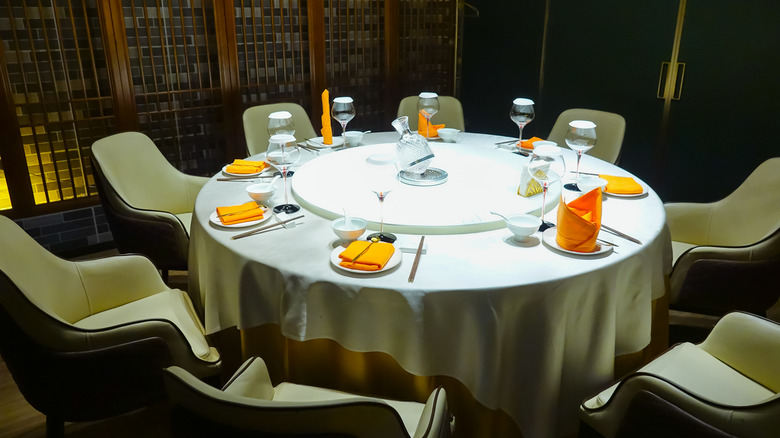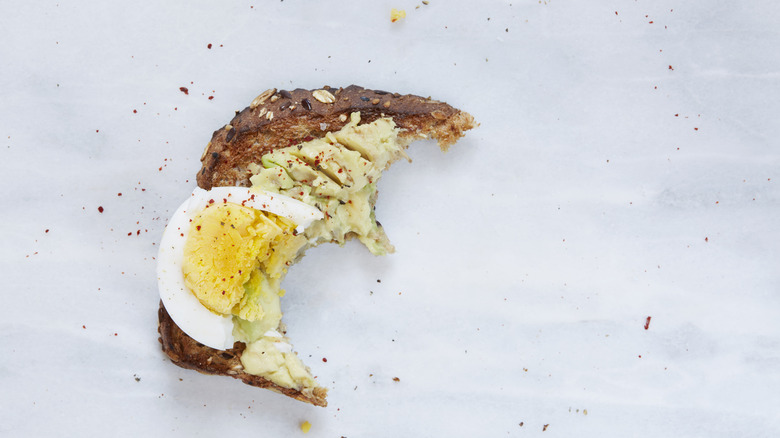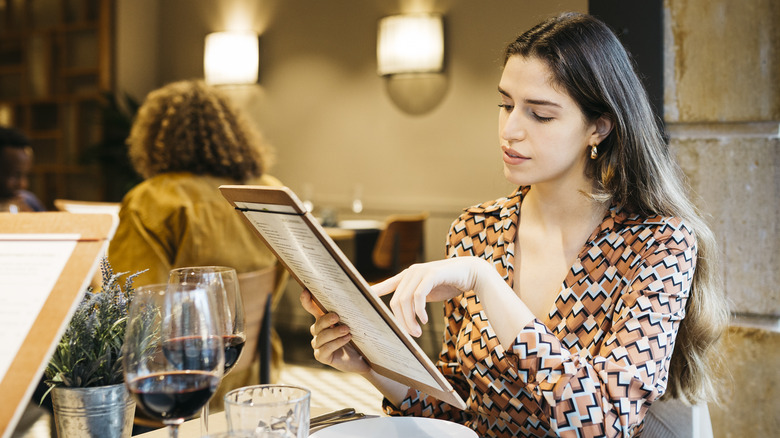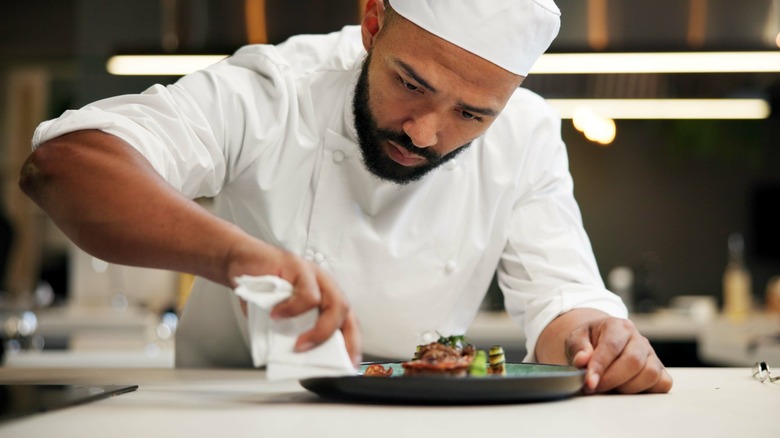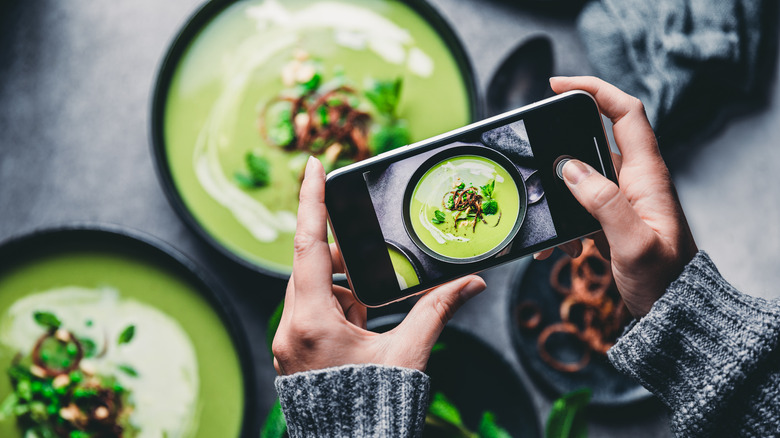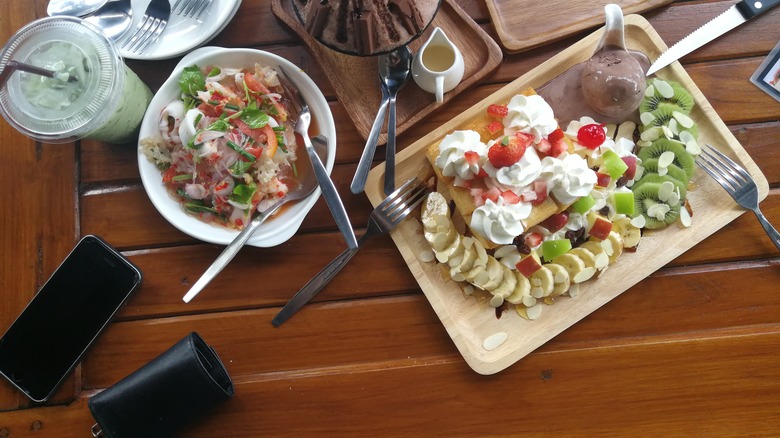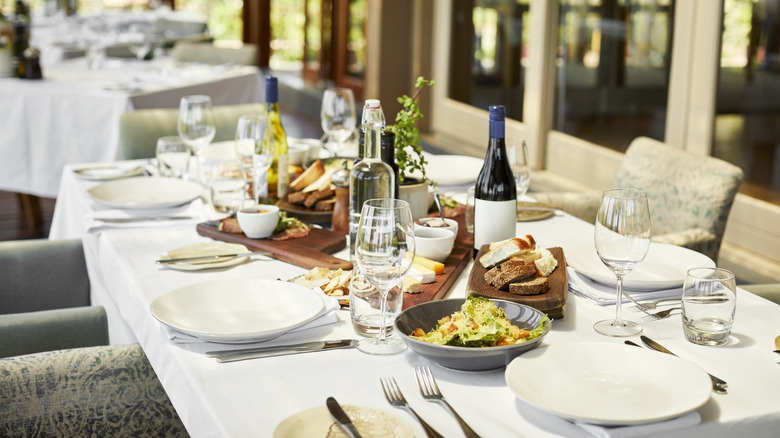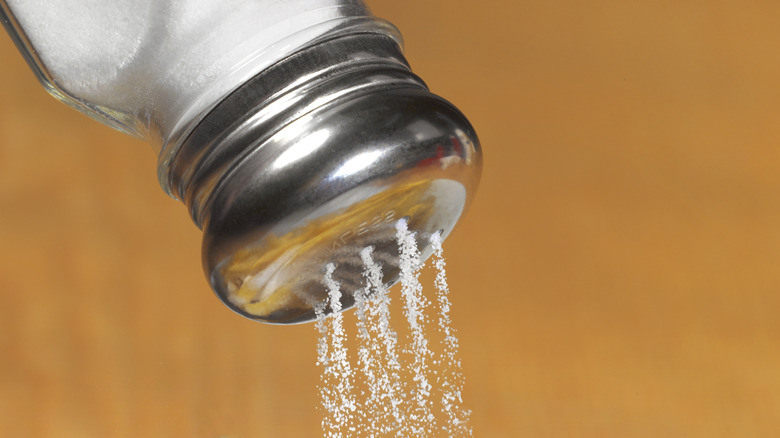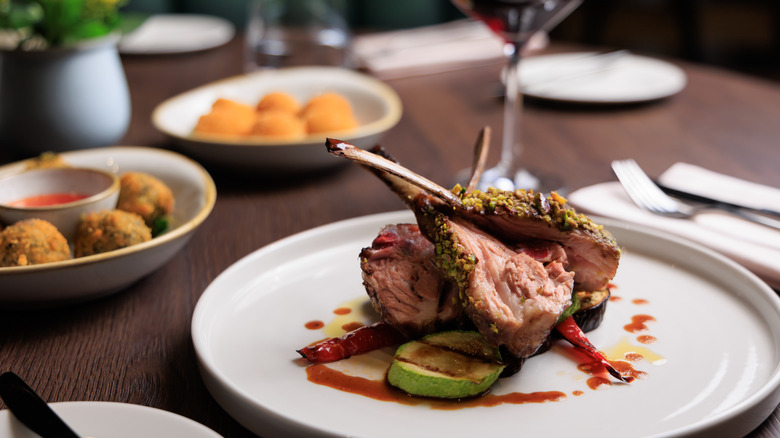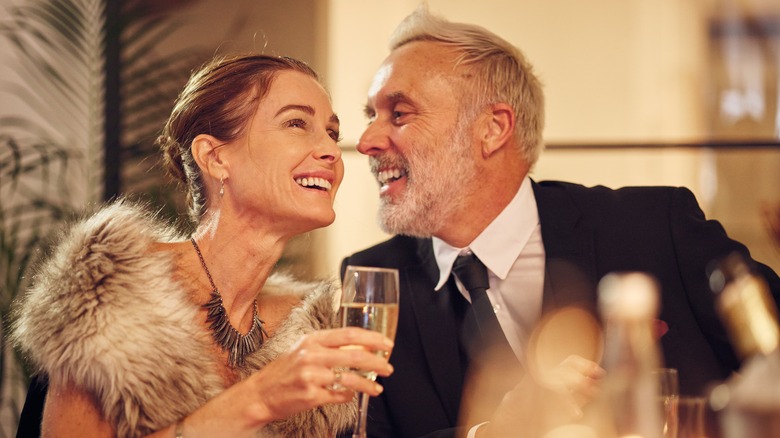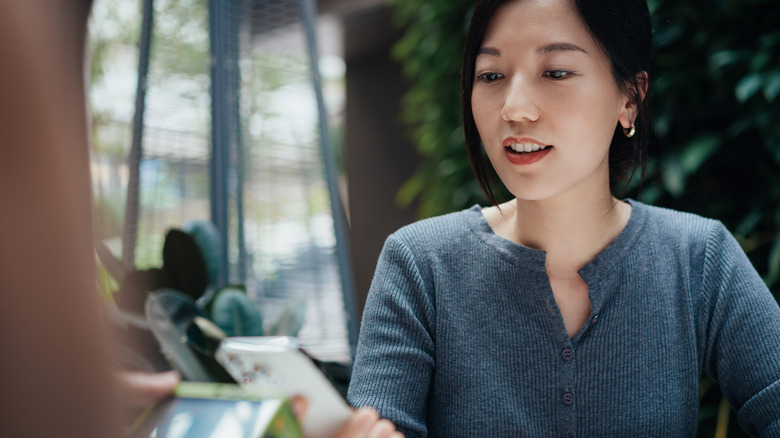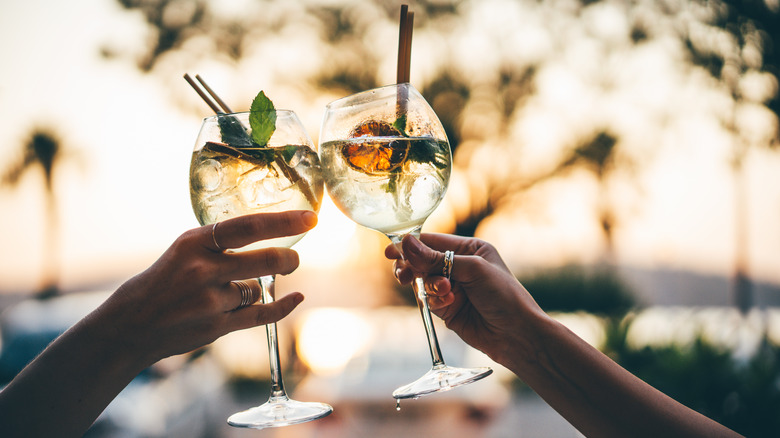7 Rules Of Fine-Dining Etiquette To Follow, And 7 You Can Completely Ignore
For serious food lovers, a fine dining meal is a much-anticipated pleasure. We're happy to scrimp and save for a few months to treat ourselves to an evening at a bucket-list restaurant. And a wise choice will reward our efforts many times over — we'll experience exquisitely plated bites, each on its own specially chosen plate, rare wines to complement each course, and polished service from professionals who understand how much this meal means to us.
But for those of us who rarely venture into a restaurant fancier than Applebee's, the prospect of fine dining can be intimidating. Much as we'd love to experience the wonders of molecular gastronomy for ourselves, we don't want to stumble through our meals looking like uncultured boors. The hushed atmosphere and preponderance of curious utensils can feel like an alien environment. But have no fear, it's not as complicated as it looks. To unlock the code to proper behavior in a fine dining restaurant, we've enlisted the advice of four etiquette professionals: consultant Jamila Musayeva, author and podcaster Richie Frieman, consultant and writer Jo Hayes, and consultant Lisa Mirza Grotts.
Do: Put your napkin on your lap as soon as you're seated
A noticeable difference between a fine-dining restaurant and usual fast-food hangouts is nicer napkins. Instead of a dispenser of disposable napkins or a paper napkin rolled around your flatware, you get a large, starched cloth napkin, often folded into a fan, flower, or other eye-catching form. It's just one of many visual reminders of the extra care and attention that will go into your dining experience, and it's natural to want to leave it in front of you and savor its elegance until it's time to put it to use.
But while this may seem like the respectful thing to do, tradition dictates differently. "Napkins should be placed on your lap as soon as you are seated and should remain there until the meal concludes, after which it is placed neatly to the left of your plate," Jamila Musayeva said. If you must leave the table during your meal, place your napkin on your chair (an essential napkin etiquette tip): This will let your server and fellow diners know that you intend to return.
Don't: Chew with your mouth open
This may seem obvious, but when you're caught up in the excitement of a special meal, it's easy to get carried away with the food and conversation and lose track of what you're doing. But neglecting fundamental etiquette won't reflect well on you. "I can't tell you how many times I've witnessed this in the wild and lowered my expectations of said open-mouth chewer," Richie Frieman said about open-mouth chewers.
You need not spend your meal in a self-conscious state of paralysis to practice proper behavior, however. A rule of thumb that will keep you out of trouble is to read the room and make sure your actions reflect the ambiance of the meal. "One of the most common mistakes is a lack of awareness of the surroundings," Jamila Musayeva said. "For instance, speaking too loudly, using mobile phones at the table, or ignoring the dress code can disrupt the refined atmosphere of a fine dining establishment." And Frieman offers another reason to mind your manners at a fine dining restaurant: "One area where fine dining etiquette comes into play is that it's often been used as a secret deciding factor for job interviews," he warned. "Having good manners means you'll treat clients well and not gross them out."
Do: Hold out chairs for others
Fine dining restaurants may often be places to experience cutting-edge culinary techniques and experimental cooking styles — but when it comes to expected behavior, old-fashioned rules to apply. Think back to all the instructions you got from your grandparents or other older relatives that you dismissed as hopelessly irrelevant, such as the old tradition of holding chairs out for women or older guests. Well, in fine-dining contexts, these rules are very much still in operation.
"In fine dining, certain traditional rules remain timeless because they are rooted in respect and consideration for others," Jamila Musayeva said. "Holding out a chair for someone, particularly a lady, is a gesture of chivalry and attentiveness that continues to be valued. Similarly, keeping elbows off the table is a practice that reflects self-discipline and creates a tidy dining space. These traditions endure because they contribute to a refined and courteous dining experience, which is the essence of fine dining." In short, part of your role as a diner in a fine-dining establishment is to ensure your dining companions enjoy themselves, as well. "It doesn't matter what type of dining event it is or your level of relationship to the person sitting across from you — you should always keep yourself in check when it comes to manners," Richie Frieman said.
Don't: Take huge bites
While some fine-dining rules may seem arbitrary and arcane at first glance, most of them are grounded in the same common-sense assumptions that govern everyday dining (no one at McDonald's wants to see you chewing with your mouth open, either). For instance, another basic rule that's easy to forget is to take your time and not wolf down your food. Eager as you might be to try everything, remember you're having a special meal that deserves to be savored and appreciated. "Man or woman, it doesn't matter, you should always aim for delicate," Richie Frieman said.
Part of eating delicately, Frieman added, is proper use of your utensils. "Always use the fork and the knife together. They're a team for a reason!" he said. "Use the knife to gently push food onto your fork." In addition, he said, a proper grip on your utensils will make a good impression on your table-mates. "Don't hold the fork like it's a hammer or the knife like it's a javelin. Prongs down into the dish, the knife does the rest, and then take smaller bites."
Do: Follow cues from others when ordering
Ultimately, a fine-dining meal is a performance: You don't pay hundreds of dollars per person simply to refuel, no matter how amazing that fuel may be. Instead, you go for the experience: The décor, the ambiance, the service, and the rhythm of the meal, along with the food itself, are what make fine-dining meals special and memorable (and they can actually make the food taste better). And unless you're dining solo, fine dining is a team activity — everyone at the table must help ensure everyone else has a comfortable and pleasant experience.
This means you should stay mindful of your fellow diners and their expectations. When ordering your meal, for example, you should respect the overall rhythm of the meal dictated by the others. "With regards to appetizers, many people often prefer to skip the starter and head straight into the main," Jo Hayes said. "The correct way to approach this is to simply ask the question of fellow diners — 'shall we order appetizers?' Whatever the general consensus is, generally, the polite rule is to go with the group." This does not mean, however, that you need to stuff yourself to be polite. "One diner may not desire dessert, so it is perfectly acceptable to decline dessert, while fellow diners/tablemates order dessert," Hayes said.
Don't: Assume kitchens can accommodate unusual requests
Serious food sensitivities are no fun. Whether you have a gluten intolerance or an allergy to citrus, you've probably found that eating out can feel like navigating a minefield — every new dish can bring hidden dangers. You hate being that annoying diner who always gives servers the third degree about sauce ingredients and cross contamination. But you hate ending up in the emergency room even more.
And in fine-dining contexts, where chefs put even more effort than usual into their meals, you may feel especially self-conscious making special requests. But according to Jo Hayes, you need not worry if your sensitivity is a common one. "Most restaurants are more than able to accommodate standard allergies, such as gluten/dairy, etc.," she said. "Simply make the request when the waiter comes to take the table's order." If you have a less-common sensitivity or dietary prohibition, however, it's best to call the restaurant ahead of time to ensure the kitchen can accommodate your needs. "It's rather awkward to arrive at a restaurant, to be fully seated to find that one can't order a suitable meal — prior reconnaissance is key," Hayes said. Even if it's a not-so-secret off-menu dish you've heard of people raving about, that doesn't mean the restaurant can prepare it for your meal.
Do: Photograph your meal quickly and discreetly
When an exceptional example of it happens to be placed right in front of us, we want to whip out our phones and take a few pictures of it, not only to memorialize the moment for our own benefit, but to share it with friends and family. No one would think twice about doing this in a casual mom-and-pop restaurant (where the owners almost certainly welcome the free publicity), but one doesn't want to run afoul of the unspoken codes in a fine-dining restaurant. But missing that once-in-a-lifetime shot would be a real loss, too. What's a conflicted diner to do?
While constant fiddling with one's phone is bad form in a fine-dining restaurant, a few quick and discreet photos are acceptable. "Taking pictures of one's meal is fine, as long as it's done discretely, and quickly — no 10-minute photo shoot here," Jo Hayes advised. "A quick pic or two is fine — anything longer is considered 'naff' — supremely poor taste." So feel free to document your special meal — but leave the light reflector and ring light at home.
Don't: Keep keys, phones, or other belongings on the table
In a fine-dining restaurant, the food and your fellow diners should be the center of your attention. So while many of us habitually keep our wallets, keys, and phones on the table at casual business lunches, this is a major faux pas in a fine-dining setting. "Mobile phones are a big etiquette issue. There is much deplorable conduct with regards to phone etiquette in restaurants. They should be out of sight, and out of sound (i.e. off the table and on silent). There should be no rings or dings heard," Jo Hayes said.
The reasons for this prohibition are obvious. For one, elaborate place settings with multiple glasses, plates, and sets of utensils don't leave much room on the table for personal belongings. More importantly, though, they ruin the ambiance of a special meal: You're there to escape from everyday concerns, not to engage with them while you eat. And no one wants to hear your phone conversations. "No phone calls," Hayes said. "Text messages should also be avoided (if absolutely necessary, do so discretely)." So if an emergency arises and you must use your phone, it's best that you step outside.
Do: Use utensils from outside in
For newcomers to fine dining, one of the most intimidating elements of the meal is the complexity of the table settings. You may see several wine glasses in front of you, and instead of getting just a knife, a fork, and a spoon, you will likely encounter two or more of each, in different shapes and sizes. This can be enough to send you into decision paralysis: Which of these are you supposed to use, and when?
Fortunately, a simple principle can get you through the meal with your dignity intact. "Always start with the outermost utensils and work your way in with each course," Jamila Musayeva said. This means the first fork and knife you use will be the ones furthest from your plate. As for the rest of your place setting, Richie Frieman offers the memory hook BMW (bread, meal, and water, ordered from left to right): Your bread plate is to the left of the main dish plate, and your water should be behind it and to the right. "This way, you're not saying, 'Is that my drink?' after 20 minutes," Frieman explained. And if you find yourself with an especially baffling array of silverware and glasses, Lisa Mirza Grotts shares a pro tip for faking it with style: "Think of Julia Roberts in "Pretty Woman" and mimic what the person across from you is doing," she advised.
Don't: Season your food before you taste it
In fine dining, it's important not just to show respect for your fellow diners, but for those who make and serve your food. You may be dining like a bigwig, but this does not give you the right to take restaurant staff for granted. Chefs at fine-dining restaurants worked hard to earn their positions and put a lot of thought and effort into designing and executing their signature dishes. And while you're not required to love everything they serve you, good etiquette requires that you treat their efforts seriously (and creating quality, original dishes are part of how a restaurant earns a Michelin star, after all).
According to Richie Frieman, approaching each course with respectful curiosity also reflects better on you. "Never season your meal before you taste it," he said. "It shows great disrespect for the chef. It also shows that you are impulsive and that you can't wait to see how it tastes first."
Do: Wait for everyone to be served before eating
In fine-dining restaurants, the highly trained cooks and waitstaff do their best to ensure everyone at a table gets their courses at the same time. But even the most skilled server has only two arms, and if you're dining with a large party, some diners will inevitably get their food before others. If you're among the first to be served, you can show your courtesy to your fellow diners by holding back until everyone else has their food. "When your plate arrives, wait until everyone at the table has been served before starting to eat," Jamila Musayeva said.
Not all etiquette experts, however, agree that this should be a hard-and-fast rule. "One rule that needs to be rewritten is that you can only eat your meal once others get their dishes," Richie Frieman said. "Yes, you don't want to go to town on your meal while they wait for theirs, but there is a golden rule: If it's hot, you can eat it without waiting. If you don't do that, you're ruining your experience and not allowing the chef's work to be appreciated."
Don't: Overdress
Traditionally, fine dining meant your finest formalwear and jewelry. But in recent years, high-end restaurants have gradually loosened their dress codes (like the ability to keep your hat on your head when dining), and, today, you can find plenty of fine dining options that will welcome you even if you don't own a mink stole or a drawer full of diamonds. "The dress to impress rule has taken a dive due to our casual way of living since the pandemic of 2020," Lisa Mirza Grotts said. Jamila Musayeva agrees. "The notion that one must always dress in formal attire for fine dining has relaxed, allowing for a more personal and creative expression while still adhering to the venue's dress code," she said.
Yes, many fine dining restaurants still have dress codes — just not as strict or as formal as in previous years. Ruth's Chris Steakhouse, for instance, simply asks guests to refrain from wearing tank tops, logo shirts, gym or pool attire, or clothes that reveal one's underwear. Other restaurants ask for business elegant attire (jackets and dress shirts for men, but ties not required; a blouse and dress pants for women). Restaurants with dress codes generally include them on their websites. But if you have questions, check with the restaurant before you go.
Do: Handle payment interactions discreetly
While fine dining restaurants remain bastions of old-fashioned manners, they, too, have adapted to accommodate changing social expectations. "For instance, the strict separation of conversation topics based on gender or the expectation that only men can pay the bill are practices that no longer align with modern values of equality and inclusivity," Jamila Musayeva explained.
In addition, technology innovations such as web-based reservation platforms and mobile payment apps have also impacted the fine dining experience and have introduced new etiquette concerns aside from being a bad tipper. "When using online reservation platforms, it's important to honor your commitment and cancel in a timely manner if plans change," Musayeva said. "Similarly, when using payment apps, it's polite to discreetly handle transactions to maintain the ambiance of the dining experience." If it's any consolation, restaurants have also experienced growing pains as they navigate this new landscape. "I dislike the fake 'convenience' of the waiter swiping your card at the table and then signing the tip. This is way too invasive and makes for an awkward interaction between all parties," Richie Frieman said.
Don't: Forget why manners matter
After reviewing all these do's and don't's, you may get the suspicion that a fine-dining meal is a form of live-action role playing, but instead of pretending to be a knight in battle, you're pretending to be a fancy person who understands how finger bowls work. In reality, however, fine dining rules aren't there to trip you up, but to give you and your fellow diners a more pleasant experience. "These rules uphold the dignity of the human person," Jo Hayes said. "These rules apply especially in a fine dining establishment, which people patron[ize] specifically because such venues are purposeful about maintaining a certain standard of etiquette, protocol, and conduct."
So you don't have to pretend to be someone else in a fine-dining restaurant — just be your best, cleaned-up self and be mindful of how your actions impact the mood of the meal. For those of us who've grown accustomed to casual solo or family meals, this may require an extra level of self-monitoring. Richie Frieman said, "Fine dining is an experience. Part of the experience is the requirement to abide by a certain level of class." More specifically, Hayes advises diners to watch their volume and avoid foul or abrasive language. "Our conversation should not be audible/a distraction to neighboring tables," she said.
